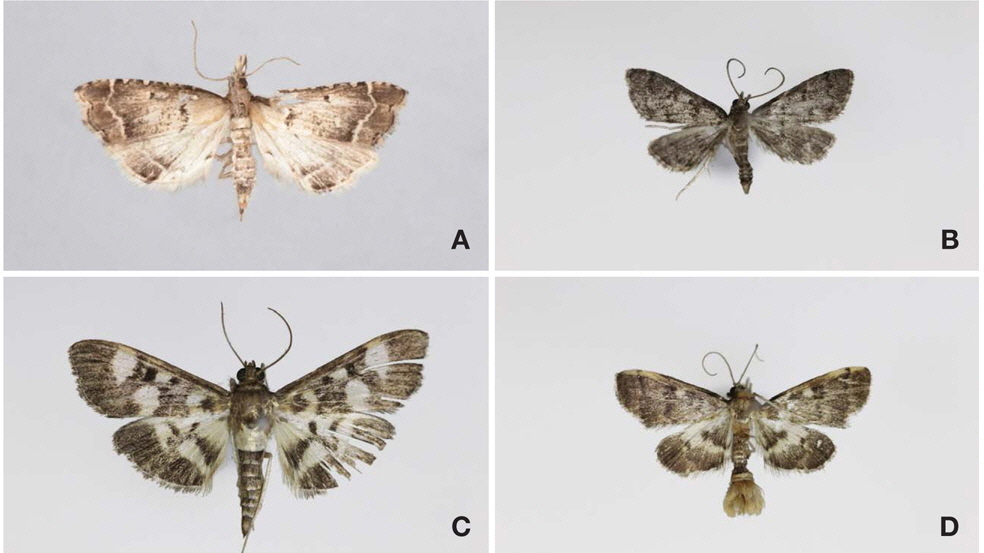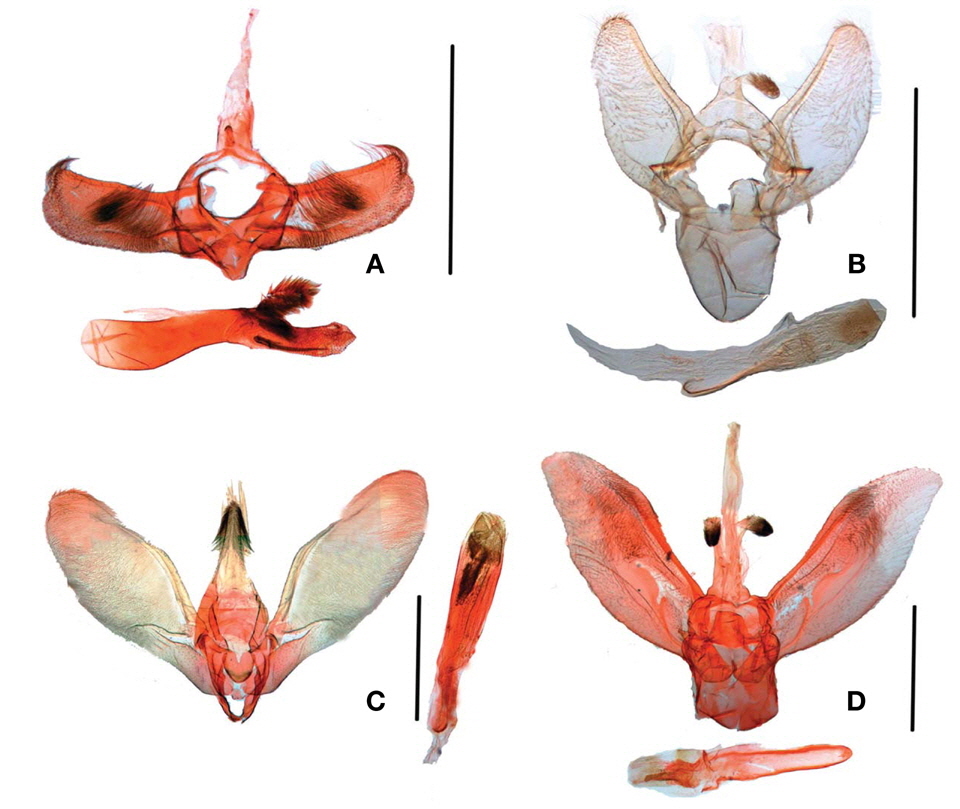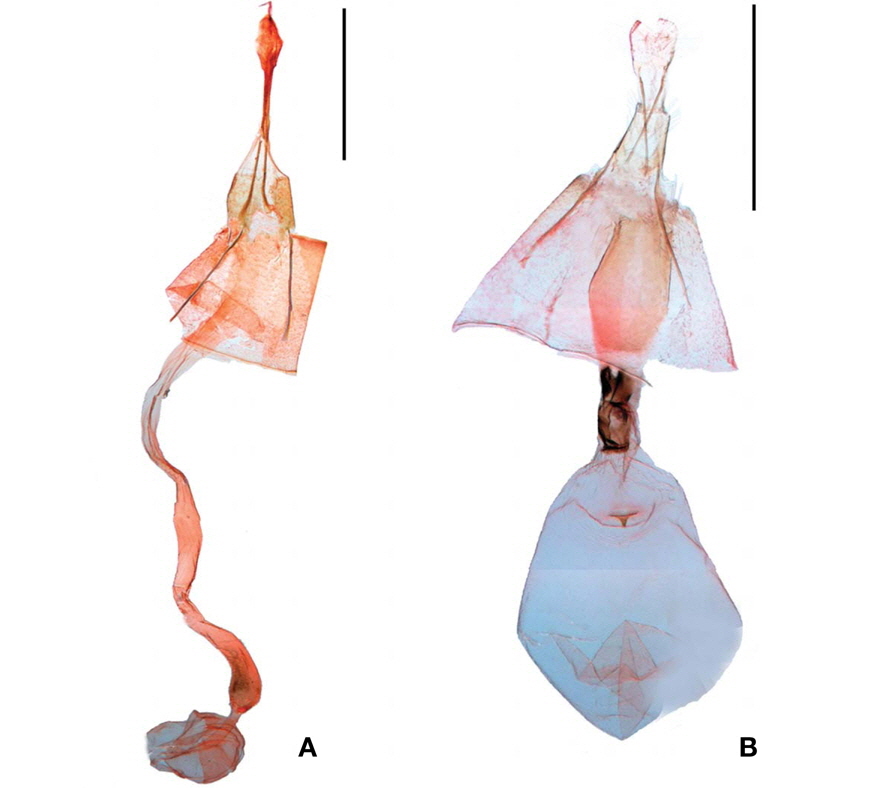



This study was carried out to report the newly recorded species of the family Crambidae, belonging to the order Lepidoptera. During the course of investigation on the family Crambidae in South Korea, the following four species are reported for the first time from Korea: Diplopseustis perieresalis (Walker, 1859), Dolicharthria bruguieralis (Duponchel, 1833), Herpetogramma ochrimaculale (South, 1901), and Omiodes diemenalis (Guenée, 1854). Among them two genera, Diplopseustis Meyrick and Dolicharthria Stephens, are also newly reported from Korea. External and genital characteristics of adults were examined and illustrated. All of the newly recorded species were enumerated with their available information including the collecting localities, illustrations of adults, and genitalia.
Until now, more than 16,000 species of the superfamily Pyralodiea have been recorded in the world (Munroe and Solis, 1999). In Korea, a total of 349 species of the superfamily Pyralodiea have been known to date (Bae et al., 2008). Later Kim et al. (2012) added two newly recorded species from Korea,
Thus, the aim of this study is to report four newly recorded species and to update our knowledge with recently collected data on the fauna of Crambidae of Korea. All of the examined materials for each species are enumerated with their localities and available information.
Materials examined in the present study are preserved in the Systematic Entomology Laboratory, Hannam University (SELHNU), Daejeon, Korea. The genitalia of both sexes were dissected and examined after mounting with Euparal mountant for identification of the species. The photos of adults and genitalic structures for the species were taken by a digital camera, Pax cam (PAXcam Microscope Cameras Co., Chicago, IL, USA) attached on the microscope, Carl Zeiss Axio Imager A1 (Carl Zeiss Ltd., Cambridge, UK). Abbreviations used in this study are as follows: TL, type locality; TS, type species; GS, genitalia slide number.
Order Lepidoptera Linnaeus, 1758Family Crambidae Latreille, 1810Subfamily Pyraustinae Meyrick, 1890=Spilomelinae Guenée, 1854
Genus Diplopseustis Meyrick, 1884: 284TS: Cymoriza minima Butler, 1881
Ambia perieresalis Walker, 1859b: 958. TL: Borneo.Cymoriza minima Butler, 1881: 684. TL: Taiwan.Sufetula nana Warren, 1896: 225. TL: India.Diplopseustis minima Meyrick, 1884: 285.Diplopseustis perieresalis Hampson, 1896: 489.Diplopseustis perieralis Dugdale, 1973: 202.Diplopseustis periersalis Mackay and Fray, 2002: 26.
Material examined. Korea: 2♂2♀, Gyeongsangnam-do, Isl. Geoje, 25 Sep 2012, Kim SS, GS 5124-coll. SELHNU; 1♂, Gyeongsangnam-do, Isl. Geoje, 25 Aug 2012, Kim SS, GS 5126-coll. SELHNU.
Adult (Fig. 1A). Wingspan 12-14 mm. Head light gray, antenna brownish mixed gray color. Thorax light brown. Forewing with ground color brownish; yellowish spots presented along the costa; a small blackish round shape speck near discoidal cell; postmedial line with yellowish gray; outer margin presented blackish brown line with light brown scales, costa straight. Hindwing with ground color light gray; outer margin light gray with same postmedial line color as forewing; tornus blackish scales, cilia whitish color basally.
Male genitalia (Fig. 2A). Uncus very short, rounded terminally. Anal tube very long with narrow to the top. Valva broad and expanded; bundle of long hair on basal margin; apex of valva hook shaped bearing slightly long hairs; outer margin gentle curved. Sacculus broad with short hairs on basal margin. Juxta narrow to the bottom. Aedeagus stout, narrowed towards apex, with a bundle of short hair on vesica.
Female genitalia (Fig. 3A). Papillae analis narrow, very long. Apophyses anteriores as long as half of apophyses posteriores. Ostium bursae narrow, well sclerotized. Ductus bursae very long as long as 1/4 of corpus bursae. Corpus bursae very small, globular shaped, slightly sclerotized around entrance with no signum.
Distribution. Korea (new record), China, Japan, Taiwan, Boreno, Indonesia, Malaysia, Brunei, Australia, Portugal, Spain, Canary Islands, Netherlands, England.
Host plant.
Genus Dolicharthria Stephens, 1834: 55TS: Scopula longipedalis Curtis, 1830
Dolicharthria bruguieralis Duponchel, 1833: 320. TL: France.Diasemia calcaralis Strand, 1918: 73. TL: China, Taiwan.Metasia coniotalis Hampson, 1903: 220. TL: Japan, China, India.Stenia adelalis Guenée, 1854: 245.Stenia bruguieralis tenebrosa Rothschild, 1929: 233. TL: Morocco.
Material examined. Korea: 2♀, Gangwon-do, Inje-gun, Mt. Bangtaesan, 21 Aug 2012, Kim SS; 1♂1♀, Gyeongsangbuk-do, Yeongcheon-si, 13 Jul 2012, Kim SS, GS 5129-coll. SELHNU; 1♀, Gyeongsangbuk-do, Naribunji, Isl. Ulleung, 8 Aug 2012, Kim SS, GS 5128-coll. SELHNU.
Adult (Fig. 1B). Wingspan 9-11 mm. Head light brown, antenna brownish. Thorax brownish mixed gray scales. Forewing with ground color brownish; a small blackish round shape speck near discoidal cell; postmedial line with blackish brown; outer margin presented light brown scales, costa straight with somewhat rounded apex. Hindwing with ground color blackish brown; outer and inner margin light brown scales; cilia light brown color basally.
Male genitalia (Fig. 2B). Uncus very long, rounded terminally. Socii relatively small; tongue shape with black terminal. Valva broad and expanded; bundle of long hair on basal margin; apex of valva curved bearing slightly long hairs; outer margin gentle curved. Sacculus broad with short hairs on basal margin. Juxta broad to the bottom. Aedeagus stout, wide towards apex, ductus ejaculatorius presented.
Female genitalia (Fig. 3B). Papillae analis slightly long, narrow, covered numerous short hairs. same ground color as forewing Apophyses anteriores almost same length as apophyses posteriores. Ostium bursae wide, rounded. Ductus bursae short; slightly wide in diameter, well sclerotized from enterance to middle. Corpus bursae large, pear shaped, with a small thorn like signa.
Distribution. Korea (new record), China, Japan, Taiwan, India, France, Libya, Israel, Morocco.
Host plant.
Genus Herpetogramma Lederer, 1863: 430TS: Herpetogramma servalis Lederer, 1863
Acharana Moore, 1885: 285.Coremataria Amsel, 1956: 207-208.Culcitaria Amsel, 1957: Pl. 39, fig. 1.Macrobotys Munroe, 1950: 228.Pachyzancla Meyrick, 1884: 315.Pantoeocome Warren, 1896: 173.Piloptila Swinhoe, 1894: 142.Ptiloptila Hampson, 1899: 201.Stenomelas (sic.) Hampson, 1912.Stenomeles Warren, 1892: 437.
Nacoleia ochrimaculalis South, 1901, in Leech, 1901: 460, Pl. 15: 28.
Material examined. Korea: 1♂, Gyeongsangbuk-do, Naribunji, Isl. Ulleung, 8 Aug 2012, Kim SS, GS 5121-coll. SELHNU.
Adult (Fig. 1C). Wingspan 24 mm. Head dark brown, antenna blackish brown. Thorax dark brown, mixed with yellowish gray scales. Forewing with ground color yellowish dark brown; dark brown scales along the costa, four yellowish white round shape specks, two blackish spots presented near discoidal cell; apex and posterior margin blackish brown. Costa straight, with somewhat rounded apex. Hindwing with same ground color as forewing, a blackish brown area form 1/3 of hindwing; antemedial and postmedial line blackish gray. Cilia dark brown, mixed with grayish color basally.
Male genitalia (Fig. 2C). Uncus long, rounded terminally with numerous blackish hairs from middle to the top. Valva broad and expanded; sclerotized costa towards apex; apex of valva softly curved. Transtilla heart shape. Sacculus slightly narrowed. Juxta narrow to the bottom. Aedeagus slighty stout with narrowed towards apex; ductus ejaculatorius very long.
Female genitalia. Unknown.
Distribution. Korea (new record), China, Japan.
Host plant. Unknown.
Genus Omiodes Guenée, 1854: 355TS: Omiodes humeralis Guenée, 1854
Charema Moore, 1888: 218.Coenostola Lederer, 1863: 408-409.Coenolesta Whalley, 1962.Deba Walker, 1866: 1494.Hedylepta Lederer, 1863: 409.Hedilepta Lederer, 1863: 279.Heydelepta Dyar, 1917: 70.Lonchodes Guenée, 1854: 354.Loxocreon Warren, 1892: 432.Merotoma Meyrick, 1894: 460.Pelecyntis Meyrick, 1884: 315.Phycidicera Snellen, 1880: 71-72.Spargeta Lederer, 1863: 406-407.
Omiodes diemenalis Guenée, 1854: 203. TL: Tasmania.Asopia lydialis Walker, 1859a: 374-375.Botys ustalis Lederer, 1863: 375, 471, Pl. 10, fig. 14.Omiodes diementalis Inoue, 1996: 92.Hedylepta pyraustalis Snellen, 1880: 71.Pyralis incertalis Walker, 1866.Pyrausta absistalis Walker, 1859a: 311-312.
Material examined. Korea: 1♂, Gyeongsangbuk-do, Naribunji, Isl. Ulleung, 8 Aug 2012, Kim SS, GS 5122-coll. SELHNU.
Adult (Fig. 1D). Wingspan 17 mm. Head light brown, antenna blackish brown. Thorax blackish brown, mixed with yellowish scales. Forewing with ground color blackish brown; yellowish scales along the costa, yellowish white round shape specks presented near discoidal cell; apex and posterior margin blackish brown, mixed with gray scales. Costa straight. Hindwing with blackish brown ground color mixed white scales, a blackish brown area form 1/2 of hindwing; antemedial and postmedial line blackish gray. Cilia light brown, mixed with whitish color basally.
Male genitalia (Fig. 2D). Uncus very long, rounded terminally. Socii relatively small; tongue shape with black terminal. Valva broad and expanded; long hair on basal margin; costa of valva rapidly soar to up to 2/3, then curved to apex straightly; outer margin has a soft line. sacculus narrow with short hairs on basal margin. Juxta expanded to the bottom. Aedeagus relatively big and long.
Female genitalia. Unknown.
Ditribution. Korea (new record), China, Japan, Taiwan, Malaysia, India, Australia, Samoa, Africa.
Host plant.
In this study, four species of Crambidae,



